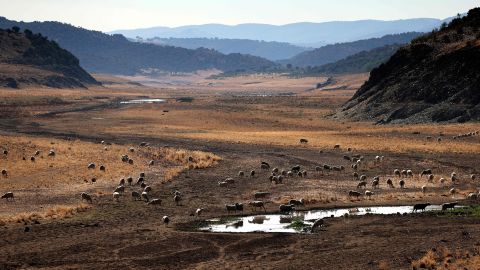CNN
—
The planet could cross critical global warming thresholds sooner than previous models predicted, even with concerted global climate action, according to a new study using machine learning.
The study estimates that the planet could reach 1.5 degrees Celsius of warming above pre-industrial levels within a decade, and found a ‘substantial possibility’ of global temperature increases exceeding the 2 degree threshold by mid-century, even with major global efforts to reduce global-warming pollution.
Data shows that the average global temperature has already increased by around 1.1 to 1.2 degrees since industrialization.
“Our results provide further evidence of high-impact climate change over the next three decades,” notes the report, published Monday in the journal Proceedings of the National Academy of Sciences.
Under the 2015 Paris Climate Agreement, countries pledged to limit global warming to well below 2 degrees – and preferably 1.5 degrees – above pre-industrial levels.
Scientists have identified 1.5 degrees of warming as a key tipping point beyond which the risks of extreme floods, droughts, wildfires and food shortages will increase dramatically.
Temperature rises of more than 2 degrees could have catastrophic and potentially irreversible effects, including plunging three billion people into “chronic water scarcity”.
The study used artificial neural networks – a type of machine learning or artificial intelligence – which the scientists trained on climate models and then used historical observations of temperature around the world “as an independent input to from which the AI makes a prediction,” said Noah Diffenbaugh, a Stanford University professor and co-author of the study.
Diffenbaugh and co-author Elizabeth Barnes, a professor at Colorado State University, assessed three different scenarios: low, medium, and high “forcing” climate pathways, which refer to the intensity of warming caused by greenhouse gases in the atmosphere.
In all three scenarios, scientists estimated that the world would reach 1.5 degrees of warming between 2033 and 2035, even if the pollution that warms the planet is significantly reduced.
Diffenbaugh said that while “individual years are likely to reach 1.5 degrees earlier”, their predictions “focus on the time until the global average temperature is warmed by 1.5 degrees”.

The study’s prediction is consistent with previous models. In a major report published in 2022, the Intergovernmental Panel on Climate Change (IPCC) estimated that the world could cross the 1.5 degree threshold “in the early 2030s”.
Where the study deviates from many current projections is in its estimates of when the world will cross the 2-degree threshold.
While the IPCC predicts that under a low-emissions scenario, global temperature rise is unlikely to reach 2 degrees by the end of the century, the study yielded more concerning results.
AI has predicted a roughly 80% chance that 2 degree warming will be reached before 2065, even if over the next half century the world reaches net zero – where it eliminates at least as much pollution of the atmosphere that warms the planet that it emits.
If emissions remain high, Diffenbaugh said, the AI has predicted a 50% chance that 2 degrees will be reached before 2050.
There is “clear evidence that half a degree of global warming poses substantial risks to people and ecosystems. Therefore, the greater the global warming, the greater the adaptation challenges,” Diffenbaugh said.
While many net zero decarbonization commitments and targets have been designed to keep global warming to 1.5 degrees, he added: “The AI predictions in our study suggest these may be needed to avoid 2 degrees “.
The use of machine learning to make predictions is on the rise in climate science, Diffenbaugh said.
“AI is able to learn the most reliable indicators of the time remaining until a given level of global warming is reached in a large number of sometimes conflicting climate model predictions.”
